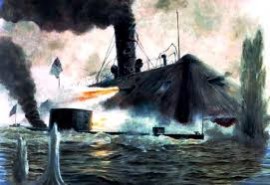Today’s Civil War Caturday (by the way, that’s pronounced “Kivil War Katurday”), right in the middle of Easter. Got me thinking about my religion, if I have one now, and I realized I do, kind of: The Monitor and the Merrimack.
If there’s an idea of god I could buy, it’s the two ironclads, total opposites, fighting each other. That scene is burned in my brain—and not just mine, either. Real Americans see it all over the place, which is why there’s a rock formation in Moab, Utah, called “Monitor and Merrimack.” We see those two shapes the way Richard Dreyfuss saw Devil’s Mountain in Close Encounters.
Monitor and Merrimack, Moab, Utah
For you heathen who weren’t raised right, the Monitor and Merrimack were the first two ironclad warships in combat. They fought to a draw in March, 1862, at Hampton Roads, a harbor near the mouth of the James River that flows down from Richmond, capital of the Confederacy. There’s something permanent about their fight, though. In a way, if you believe in it like I seem to, it’s like it never ended. The Monitor and the Merrimack are still fighting, and always were fighting, even before people got the idea of building them.
They’re a perfect pair, because aside from the fact that no crummy wooden warship had a chance against either one, they have nothing in common. Even the way they were born showed how they were the heart and soul of the two totally different Americas that made them, the two Americas that were at each others’ throats then, and still are, and always will be. I’m not saying good and evil, but…yeah, I am saying good and evil, as long as I get to admit that evil has a big pull too, I’m not automatically non-stop on the side of good. But yeah, with that in mind I’ll admit: North equals good equals Monitor, and South equals evil equals Merrimack. It’s like: Yay for them both, but I hope the Monitor wins.
It never does, though. The battle always comes out a draw, because that’s the frustrating annoying way the world is set up. That draw is part of why the two ships fighting for eternity makes such a perfect religion. I never liked the idea of God being all-powerful because how come…well, never mind my fill-in details; everybody’s got their own “If God’s so nice, then how come…” to fill in.
The only way you can forgive god, or the gods, or the galaxy or whatever you call it, is if it’s not all-powerful, if it’s trying its best but having a very hard time, like the Army of the Potomac. And evil has its own problems and its own heroes and to be honest is pretty damn cool in its own right.
Evil has to improvise, like the South. They knew they couldn’t fight the North’s naval blockade ship-for-ship. The US Navy ballooned up to the biggest and strongest in the world. That’s right, “strongest”—and don’t you Brits give me your Royal Navy theme-music. I just wish, God how I wish, our navy had had a chance to slap you guys around circa 1862, when you were flirting with Dixie Cotton every time you thought her ex wasn’t looking!
So the South had to think harder, the way besieged countries do. The Merrimack came out of the same brilliant desperation that coughed up the Me262. It wasn’t as beautiful as that interceptor, though, because it was a ship brought back from the dead. The Confederate Navy wanted to build an ironclad warship from scratch but found out they just didn’t have the industrial base to make steam engines powerful enough to push all that armor plate and ordnance. So they dug up the dead US Navy steamship Merrimack, wrenched her up from the bottom of a river, cleaned her up and built a totally new superstructure for her, in-sloping walls that started with two feet of wood reinforcing, fronted by four inches of iron plate. More than anything, the reborn Merrimack looked like a WW II sub resting on the surface, with a flattened, stretched conning tower. Which is another perfect detail that can’t just be an accident, because didn’t the South raise her up off the mud and bring her a second life? And didn’t that same South give us the first working war submarine? If you ever wanted a clue that you’re dealing with the forces of the underworld (South equals under, for that matter), the history of the second life of the Merrimack would be it.
They fight forever in our heads.
And the Underworld is always good with guns. The Confederate ironclad had gaps in the armor for 10 guns, including two big Dahlgrens, the best naval guns in the world. On March 8, 1862, the Merrimack—which the Confederates called “C. S. S. Virginia,” but I’m calling it “Merrimack” because for one thing the two deities here both start with “M” and I’m not messing with something as perfect as that—sailed down the river to attack the US naval vessels anchored in Hampton Roads.
This is like the scene in every good horror film where the good people, the loyal deputies, all fire at the monster-hero without effect. The Terminator driving straight into, and I mean into, the LAPD station, that scene. The US Navy was something back then, brave, knew what they were doing—but they were in wooden ships with small cannon. They didn’t have a chance. The Merrimack, which had a few wooden steamships in tow like a bully’s hangers-on, steamed slowly up broadside to the USS Cumberland and opened fire at point-blank range, while the Cumberland’s small deck guns bounced shells off her iron sides.
Soon the Cumberland started sinking, still firing. More than a hundred sailors were dead on her decks. She went down trying to take the monster with her, just like the doomed good-guy should, because the Merrimack’s iron bow ram was caught in the Cumberland’s hull and Cumberland did her best to take the Terminator down with her. But it’s too early in the story for the monster to die, so Merrimack broke free just as Cumberland went under.
The monster needed another victim to show its strength; you know how these scenes go. So the Merrimack turned on another wooden ship, the Congress. Congress fired back for an hour—an hour, a wooden ship firing point-blank into iron plate studded with heavy artillery! Then, sinking, she surrendered. The sailors were allowed to start evacuating until Union shore batteries fired at the Merrimack. That made the Confederate captain mad and he ordered hot shot, literally hot lead, fired on the Cumberland, which burned and sank and took more than a hundred men with her. Don’t make the monster mad. It’s like these people had never seen a horror movie, which they hadn’t.
The third time, something different happens. That’s in every story I know. And that’s how it was this time. The Merrimack looks around for another target, finds the USS Minnesota. And let’s stop there. Minnesota–the state, that is–was the purest of the pure back then. The furthest north, the furthest west, the two good directions. A new state, no slaves, settled by innocent Scandinavians who never really got the Ulster crazy hum America always carried in its belly. And now this iron monster from the murkiest heat of Dixie turns on the ship named after the headwaters, where the Mississippi is still a clear little brook. It’s too perfect. Tell me this isn’t a battle of gods!
The Minnesota ran aground, like the leading lady tripping over her high heels as the monster bears down on her. But since the Merrimack, loaded down with all that heavy ordnance and iron plate, had a much deeper draft, it couldn’t even get close enough to Minnesota to kill her. So it had to draw back, sulking like Christine when some victim makes it across the ped xing, headlights just aching to plow through the cheerleader.
Now it’s night. The Merrimack steams home for repairs—Schwartzenegger digging buckshot out of his hydraulic arm in that skid row rented room—while the rest of the US Navy waits to be destroyed, one wooden ship at a time.
Except another ironclad was coming toward Hampton Roads, the equal and opposite, the good twin, as pure a product of the good, well-fed North as Merrimack was of the feral South: The Monitor. Another three-syllable “M” word. I read that in the Mayan religion, the hero is, or are, twins. I’ve always liked that idea, but not identical twins, more like opposite twins, but still twins, more like each other than they are like any of the ordinary mortals they fight for/against.
The Monitor was born in cool, rational heads, the opposite of the South’s booby-trap rigging desperation. The Monitor plans were drawn up on clean paper in the offices of brilliant, educated men. It was the child of an official body called “The Monitor Board,” appointed by Gideon Welles, Secretary of the Navy, a typical Victorian superman, and designed by John Ericcson, a Swedish engineering genius, Minnesota, Ericcson…I’m telling you, this is about the most Northerly north meeting the most Southerly south, not even geography, this is a god-fight.
The North had the immigrants’ brains, and immigrant desperation is a match for the cool Satanic inventions of the South any day. Ericcson’s design was as pure, clean, and strange as the Merrimack was ugly, dark and lethal. The turret was a perfect cylinder, the engine and hull were smooth minimal steel, everything had the almost-alien look of a truly brilliant design. Ericcson’s model was called a “Monitor” because it was like one huge eye, an armored cyclops. Or, like other people with no respect for religion said, it looked like a tin can on a board. The tin-can turret held two huge guns, 11-inch Dahlgrens. That was all that showed above water. None of the fuss and mess of other ship architecture at all. It was the cleanest design in the history of weaponry. Samurai swords look over-embroidered and busy compared to the Monitor.
And naturally it looked helpless against the big, bad, grinding mass of the Merrimack. The contrast is everything here. It’s the basis of my religion, if you want to put it that way. They’re equal, more or less, but they don’t look equal. The Monitor looks too small and fragile, like it should. But it’s faster, it’s smarter—it’s David to the Merrimack’s Goliath, only better, because that Bible story never worked for me thanks to Yahweh already declaring for David. Once an all-powerful god announces he’s on your side, where’s the suspense, where’s the heroism? There is none. David could have picked a piece of lint off his tunic and blown it toward Goliath and it would have blinded him and made him trip and break his neck. The rock was just a prop. That’s cheap, and dirty—who’s the bully anyway, Yahweh, you cheating punk up in your cloud, fixing the fight to get good odds on the little guy?
The Monitor, I keep trying to say, is a different religion, a Union religion that Yahweh would’ve had a jealous little-girl fit over. It had nothing on its side but the cool Northern brains that dreamed it up, and they hadn’t had much luck against the hot crazy demons of the South in the first year of the war. It must’ve been some seriously cold comfort for the wooden ships of the Navy to see their tuna-can savior stationing itself just offshore of the Minnesota. “Oh, great: My bodyguard, the five-foot nothing science nerd!”
When the Merrimack came out of its upriver lair at dawn on March 9 and steamed downstream to kill off the Minnesota, the Confederates didn’t even recognize the Monitor as an opposition vessel. They thought it was a spare boiler being towed across the harbor. Then the boiler opened fire with its 11″ Dahlgren, bigger than any gun the Merrimack had. The Monitor was big in offense, but a tiny target, the design goal of any armored vehicle. In fact, if those 11″ guns had been charged with a full load of powder they could have pierced the Merrimack’s hull. But the Northern design team was a little wary of that much bang in a tiny turret, and I can’t say I blame them. So the Monitor’s big shells dented but couldn’t break the Merrimack’s shell.
Merrimack fired back with a broadside that missed Monitor’s little turret but hit the Minnesota, the big TKO’d Swede Monitor was protecting. The Minnesota, game as ever, fired its cannon back, stuck there on its mudbank. A big dumb jock, but brave, and on the right side. You have to love the Minnesota. And Cumberland, for that matter. That’s what’s better about this religion: everybody’s got a good job to do, and even the evil is great.
The Merrimack: Now she is a god.
They fired at each other point-blank, with the Monitor’s big guns in their 360-degree rotating turret always bearing directly on the Merrimack, and the Merrimack’s big black slab-sides absorbing all that punishment and still spitting back shells. If the Merrimack had had solid shot for its Dahlgrens, they might have zipped right through the Monitor’s thinner armor plate. But the Underworld always has to improvise, it’s always under embargo like Dixie was, and they didn’t have solid shot in the right size, so the Merrimack had to be content with exploding shells.
Finally one of them blew just in front of the viewing slit of the Monitor’s turret and the little savior withdrew. The Merrimack was happy to call it off too, seriously dinged up, its zombie engines, that’d lain in the mud a long time before being resurrected, grumbling and threatening to quit, the armor plate buckled and bent.
Both deities steamed away and both declared victory. And both those particular ships died, in another perfect opposites way: the Merrimack died by fire, burned by her crew when her base was captured by the Union, and the Monitor died by water, sunk when high seas slopped over her little turrets out on the ocean.
But those were just the two temporary things that held the fight that day. North and South, Minnesota and Virginia, they’re still fighting. Not just in DC but my head. And in Moab. Everywhere, actually, because there are other pairs like that. For me, making up a better religion while I had to sit in the pew and listen to the grownups ranting, the Monitor and the Merrimack were just the first and best of the fighting pairs. The next I recognized was the same one every normal person has in their heads: the whale and the squid, fighting forever in your head and in the black depths of the ocean.
Other bodies, same battle
The Merrimack comes up from the mud to fight the Monitor; the whale goes down to the underworld to fight the squid. And just like the Monitor and the Merrimack are both perfect and wonderful, the whale and the squid are both great too, the muscle, big lungs and strong jaw of the whale against the cold boneless pull of the tentacles. They’re not exactly equal; I’m always on the side of the Monitor and the whale. But I worship the Merrimack and the squid too, where they belong, proper gods of the underworld.
And they fight forever, amen.
Would you like to know more? Gary Brecher is the author of the War Nerd. Send your comments to gary dot brecher at gmail dot com. Read Gary Brecher’s first ever War Nerd column by clicking here.
Click the cover, buy the book!
Read more:, Gary Brecher, The War Nerd


Got something to say to us? Then send us a letter.
Want us to stick around? Donate to The eXiled.
Twitter twerps can follow us at twitter.com/exiledonline




















88 Comments
Add your own1. Marc | April 23rd, 2011 at 10:32 am
I always assume that your tongue is firmly in cheek as you write… but damn, man, that was beautiful. Thank you for that.
2. abc123 | April 23rd, 2011 at 10:34 am
The designer of the Monitor was John Ericsson and he was from Sweden.
3. Soj | April 23rd, 2011 at 10:43 am
Oh mercy… poetry, brother, poetry!
4. Belgian | April 23rd, 2011 at 10:50 am
Wow! Thanks for bringing this back to mind! I remember seeing a movie about this fight as a kid and I was trembling with fascination! Same thing with Glory… watched it again and again… I should really do some reading on the civil war.
By the way. I watched The Blue Max again after reading about it in the comments and it was as gritty as was promised! Great movie devoid of the usual bullshit! I also just finished Generation Kill again and need a new fix… any tips?
5. AR | April 23rd, 2011 at 11:32 am
WN: You have formatting problems that makes this hard to read.
6. Aaron | April 23rd, 2011 at 11:39 am
Wow, great article, one of the War Nerd’s best! I’m not a war nerd, but even I remember reading about the great battle between the Monitor and the Merrimack as a child. Great mythical angle on it here. That took rhetorical balls to do, and it worked perfectly. Reminds me of a novel by Philip K. Dick, The Cosmic Puppets, which I was inspired to read by a review by some guy named John Dolan (nowhere near as famous as the War Nerd) in the Exile.
7. Aaron | April 23rd, 2011 at 11:48 am
P.S. Gotta disagree about David and Goliath. Yahweh obviously looks all-powerful to us now, reading the Bible through 3000 years of interpretation. Back then, in a polytheistic Israel, having Yahweh on your side didn’t necessarily make victory a foregone conclusion; the suspense was real. The story of David and Goliath was valid rhetoric.
8. Destro | April 23rd, 2011 at 11:51 am
Amen.
9. Doug | April 23rd, 2011 at 12:07 pm
I think this is your best prose ever.
10. Mustapha Mondes | April 23rd, 2011 at 12:32 pm
Yaaayyyy!!!!
11. fnord | April 23rd, 2011 at 12:37 pm
poetry!
12. hon kee mufo | April 23rd, 2011 at 12:37 pm
if there’s one thing this world needs, its a religion that both makes sense and gives human beings the inspiration to be decent. PBUY, Beecher.
13. Barak A. Pearlmutter | April 23rd, 2011 at 12:57 pm
You know how they always say it was a “miracle” that little David slew the big Goliath guy? I’ve never understood that. David used a sling to shoot a rock at Goliath and it hit him square in the head. Have you ever seen someone with a little practice at it shoot a rock out of a slingshot? It doesn’t matter how big a guy Goliath was, if he was hit square in the head with a rock like that, it would be a miracle if he *didn’t* die.
14. hey joe | April 23rd, 2011 at 12:58 pm
that was a fucking awesome post, War Nerd!
15. tom | April 23rd, 2011 at 1:00 pm
Converted.
16. ged | April 23rd, 2011 at 1:14 pm
superb.
17. Warrus Nerdicus | April 23rd, 2011 at 1:32 pm
Hollywood make this the first real steampunk movie please.
18. allen | April 23rd, 2011 at 1:35 pm
Fun article. We study the civil war here in Canada (in some school systems anyway). That might speak to a dearth of Canadian history, but let others be the judge of that.
There is definitely something about the Merrimack and the Monitor that does stick with you; at least it has with me. But somehow I think your divine cosmology is going to earn you a fair (prophets?)sum of flames from the Dixie crowd.
Off topic:
Caught this on the CNN website —
Some Libyans have mounted a very curious looking weapon on one of their technicals:
http://img200.imageshack.us/i/wtfsal.jpg/
What the hell is that?
My best guess is it came off a helicopter.
19. julian | April 23rd, 2011 at 1:40 pm
war nerd with a religious feeling! more needs to be said for the divinity in warfare. a pleasant change-up from the usual scalding irony and cynicism. Not to say those aren’t great.
20. spark | April 23rd, 2011 at 1:41 pm
Weird. I always thought of north and west as being the two good directions too.
21. ovaut | April 23rd, 2011 at 1:51 pm
This is fucking sterling.
22. J.T. Patton | April 23rd, 2011 at 2:27 pm
O Brother, we go to the same church! Except I’m a follower of Merrimac. Can you imagine the holy noise of all that ordnance plus the sound of The Great Monitor’s solid shot ricocheting off The Great Merrimac’s iron?
Like the ringing of a heavenly bell. I’m glad it was a draw. May they battle forever!
23. The Last Fenian | April 23rd, 2011 at 2:36 pm
Ah, fuck you. You’re the last Roman, just like me (OK, so like, two last Romans…)… and let’s face it, who wouldn’t rather worship the Blessed Virgin Mary rather than Anne Frank?
24. Nestor | April 23rd, 2011 at 2:46 pm
That was unexpectedly poetic.
25. Michal | April 23rd, 2011 at 2:48 pm
Beautiful. That was such an amazing story. You know, your articles are getting a lot better lately, this one was really top notch.
26. J.T. Patton | April 23rd, 2011 at 2:55 pm
And you missed a couple of analogies:
Yin and Yang
T.Rex vs. Triceratops
Keep writing!
27. Colin K | April 23rd, 2011 at 3:16 pm
Good blogging as always, Gary. It seems a pity that the Monitor and Merrimack didn’t get to go out with a bang. They both deserved that much.
Would you say, then, that the current political divide in America is at least partly due to the fact that America is more than one nation? Lord knows that the south at least still has a mid-nineteenth century hair up its ass.
28. Moriartillery | April 23rd, 2011 at 3:19 pm
The blog pictures are still broken – they’re all hyperlinked like they were just thumbnails, but the links just lead to the same image. Please, either a) make the links go to actual larger images or b) stop making the pictures links.
29. kasatka | April 23rd, 2011 at 3:22 pm
Billiant. John, you are one of the best writers alive.
30. Not that Andrew | April 23rd, 2011 at 3:44 pm
Since you witness so eloquently, I have no choice but to join your religion.
31. Tim McGovern | April 23rd, 2011 at 3:48 pm
High poetry! Pleasant in hell indeed.
All you need now is a Nathaniel Greene Revolutionary War piece and I’m yrs forever. Of course, that means nothing in the publishing world, but yr book and yr exquisite… no, I will stand back from that idolatrous heresy! Clearly Sherman was right to stop where he did, and Twain was right where he… well, he never stopped, did he? He got her done, save the Hicks or Kinison part of things, to call generations.
Yr right, and this should be linked (in a sad, poignant shot involving the recently deceased whatshisname) to Mark Ames’ Spite the Vote article.
http://exiledonline.com/we-the-spiteful/#more-28405
But really, this is the most explicit explanation of the mythology of America? It’s about the stupidity of our Founders. The Slave States get ‘how many votes?’ Fuck them.
Now, it’s about the Senate Rules, and Executive Powers. Both are hopelessly screwed. What other great power (mayans excluded, Aztec the book had a fun, sex-filled romp reason) had how many crisises facing it and refused to see a single one according to its oh-so-cheap lobbying system? Tell me again, Dick Durbin, about how poor people are bankrupting our fine nation!
Fine. There is too much unearned mythology in this great nation. So the South gets Hephaestus, the king of necessity? How does this fit in yr pantheon? I’m seriously interested. Sorry fer the length and lack of hardware specifics. I’ve read you since Taibbi.
32. Gustavo Arellano | April 23rd, 2011 at 3:58 pm
I would like to tithe what I need to join your religion, good sir…
33. j hodge | April 23rd, 2011 at 3:59 pm
Good stuff! Thanks. jimbolimbo
34. Morgan | April 23rd, 2011 at 4:08 pm
http://video.google.com/videoplay?docid=6996925898433577691# someone made a great tour video of the monitor center
35. Elzair | April 23rd, 2011 at 4:14 pm
Wow! That’s all I can say. Wow!
36. required | April 23rd, 2011 at 4:24 pm
Christ on a cactus this is the best yet of an unequalled series!
Am I really the first to bring up the Korean Turtle Ship?
Magnificent Brecher, drinking to you, one wonders if this type of double-hagiography is possible with German and Soviet tanks, or Ojibwe and Iroquois infantry, or Mongol and Kurdish cavalry, or other famous military pairs?
37. DrunktankDan | April 23rd, 2011 at 4:35 pm
Oh my fucking God(s) what an essay. I felt like I was on the deck of the Minnesota watching the whole fuckin thing and screamin epithets at those boys from ol’ virginny. Thanks for a brilliant article, Gary. One of your all time greats.
38. Victorvalley Villain | April 23rd, 2011 at 4:47 pm
Zoroaster visiting Valhalla?
39. John | April 23rd, 2011 at 4:56 pm
In a previous civil war article you wrote something about how the Union army could cut through Europe from Liverpool to Moscow, but wouldn’t get there because of the Royal Navy…yet now you think US Naval power was the strongest in the world around that time.
40. starburn | April 23rd, 2011 at 4:59 pm
Logistics of Union Navy vs Royal Navy don’t look too good for the union. The union navy was quite sensibly built to fight the civil war. Monitor style ironclads are great for costal and river work but less good if you want to get involved in transatlantic conflict. HMS Warrior on the other hand was built to fight anywhere on earth, packed more punch and could make over twice the USS Monitor’s speed. 1862 is a bad choice of year since the union navy didn’t really start racking up the numbers of ironclads until 1863.
41. F | April 23rd, 2011 at 5:18 pm
Eternal war, that is what we all worship.
42. derpotism | April 23rd, 2011 at 5:27 pm
Man, I gotta read my Civil War book on that battle again, I miss that. Also the Union ironclads that came after the Monitor were pretty awesome too. The paintings of post-monitor ironclads are nuts.
43. Victorvalley Villain | April 23rd, 2011 at 5:27 pm
Oh and if you can tell Yasha to check his sent as e-mail for some WTF Victorville lulz.
44. Pilot MKN | April 23rd, 2011 at 5:46 pm
The South was evil and Satanic? Oh, please. Spare us the hyperbole.
Name me one Northern town deliberately burnt to the ground by the Confederates to punish civilians.
Let us not forget the North was also deporting Congressmen that disagreed with it, destroying newspapers that were critical of it, imprisoning people without habeas corpus,and working to deport all blacks to Africa after the war was over.
45. Duarte Guerreiro | April 23rd, 2011 at 6:33 pm
Amen.
46. Gracchus Babeuf | April 23rd, 2011 at 6:43 pm
Holy shit. It’s not quite Brecher and it’s not quite Dolan–his two personalities are merging, and we’ll have no choice but to worship whatever emerges!
47. Queen Tamar | April 23rd, 2011 at 6:59 pm
I want Schopenhauer to be wrong. Watching Merrimacks and Monitors, hoping not to get killed or raped, there must be something else?
48. RanDomino | April 23rd, 2011 at 7:04 pm
http://en.wikipedia.org/wiki/Manichaeism
“A key belief in Manichaeism is that the powerful, though not omnipotent good power (God) was opposed by the semi-eternal evil power (Satan). This addresses a theoretical part of the problem of evil by denying the omnipotence of God and postulating two opposite powers.”
Unsurprisingly, the big bad evil guy is Moloch. That jerk seems to pop up a lot these days; Marx called Capitalism “a Moloch”; Freder repeated the sentiment in Metropolis (although apparently not influenced by Marx); the demon bull god of sacrifice is the golden calf in front of the Merrill Lynch HQ. Tyranny, conquest, and gold; I think he’s best opposed by Eris, the goddess of freedom and chaos… neither quite powerful enough to destroy the other. How perfect is it that Eris defeated Pluto (the ex-planet), the God of the Underworld?
49. aUPfinn | April 23rd, 2011 at 7:08 pm
Isn’t irony a moral force in it’s own right; I tend to think so.
50. vortexgods | April 23rd, 2011 at 7:08 pm
Ia, Ia Cthulhu Phtagn.
51. first | April 23rd, 2011 at 8:01 pm
first frost again
52. Nachtmahr | April 23rd, 2011 at 8:27 pm
too bad there wasn’t a third ship to die by air like the Silmarils
53. dorkula | April 23rd, 2011 at 8:32 pm
I was obsessed with the Monitor and Merrimack as a kid. Although I never constructed a religion around it, or even poetry like the WN has, I still worshipped that wonderful, pre-modern glimpse of modern tank vs. tank / battleship vs. battleship fighting. I even went so far as to build scale models out of wood and tin cans hammered flat. In retrospect, my models weren’t very scale at all, but I didn’t have plans; just pictures on illustrated Civil War books from the library.
I was always disappointed at how lackluster their (the real ones) one battle was, and how ignominious their ends. Still, I love you Monitor and Merrimack, although as a New England nerd I’ll always love the Monitor more.
54. Jimmy | April 23rd, 2011 at 8:34 pm
But the North won in the end. Hoo-ah!
55. Pat Kittle | April 23rd, 2011 at 9:43 pm
Yin-yang, War Nerd style.
56. Technomad | April 23rd, 2011 at 10:23 pm
Great article, absolutely great! A War Nerd Classic!
57. Svealander | April 23rd, 2011 at 10:37 pm
Beautiful
58. helplesscase | April 23rd, 2011 at 11:05 pm
Glad to see the WN develop a spiritual side. Forget what I said yesterday, this was the best post all week…Fuck it, they’re all great.
59. Mudhead | April 23rd, 2011 at 11:29 pm
NO comments on the Monitor and Merrimack? Wow, there seems to be a serious Civil War backlash among your readers, WN/JD. Fuck ’em. The War of the Rebellion is every bit as cool as you think it is so keep up the good work on Caturdays.
60. Jesse the Scout | April 24th, 2011 at 12:07 am
I just happened to read about this battle a few days ago, it did sound rather epic. It’s crazy, they went from wooden ships to fleets of steel war machines practically overnight and apparently this was the fight that triggered the revolution. You have succeeded in warping my mind into finding the Civil War interesting for the record.
61. Jack | April 24th, 2011 at 1:28 am
Amen, War Nerd. You’re a champion.
62. ApeAttack | April 24th, 2011 at 2:14 am
One of the most entertaining WN articles/posts ever.
63. paul kinsky | April 24th, 2011 at 6:43 am
Have you read anything by British author China Mieville? This whole article reads like an American take on his novel Kraken, and it’s fucking amazing.
64. Anonymous | April 24th, 2011 at 7:07 am
Now that’s a religion I can get behind.
65. Keith | April 24th, 2011 at 8:23 am
Amazing read war nerd, the best I think out of anything I’ve read of yours.
The whole Up/down north/south good/evil duality you recognized is very poetic and conjures up some awesome imagery.
Also, the whole “hero entering/battling the underworld” trope is very Campbellesque, I’m wondering if you’ve ever read “The Hero with a Thousand Faces”?
66. jonnym | April 24th, 2011 at 8:55 am
I’m all for a new American mythology, one that has the great classical elements but one-ups the old tales by adding something scientific and real-world historical. The Civil War casts such a long shadow over US culture that it seems like a good place to start. Thanks for giving me something interesting to think about this Easter, while I’m “enjoying” a boring Sunday dinner with my boring Christian relatives.
67. S | April 24th, 2011 at 8:58 am
War Nerd, you magnificent bastard, that was fantastic.
68. KA74 | April 24th, 2011 at 10:52 am
Heh, speaking of those “purest of the pure”, “innocent” Scandinavians, take a look at the Finnish Civil War.
http://en.wikipedia.org/wiki/Finnish_Civil_War
Sure, only 37,000 out of population of three million died, which even in proportion wasn’t even much of a crowd-warmer compared to Russian Civil War that followed soon after. Still, it definitely grows on you once you look at it a bit more closely. The war itself lasted only about five months, and there wasn’t any real collapse of food supply or massive epidemics, which killed huge majority of people in Russia (or in Congo for that matter). Real red-blooded effort went for most of those deaths, either on battlefield, or in summary executions of Red and White Terror. Sure, about 12,000 Reds died of starvation, Spanish Flu and other diseases in post-war concentration camps. Then again, it didn’t exactly help that the guards pretty much had an attitude that “a regular beatings with rifle butts are a perfectly good replacement for regular meals” and “packing up prisoners in ridiculously crowded rooms is a fantastic idea from the medicinal viewpoint”. Helps in culling the herd, so to speak.
The Nordic temper is kind of like a rubber band. It stretches and stretches on, but finally snaps suddenly and violently, and at that point there are no quick and painless fixes.
Of course, after the war the victorious Whites decided that ok, the rebels kind of had a point, didn’t ban the Social Democrat Party and pretty much hugged the socialist opposition to death. The process wasn’t all that quick, because Finns were (and still are, I guess) one of those tribes who think that “forgive and forget” doesn’t sound remotely as good as “nurse a grudge”, but when the Red Army decided to invade a couple of decades later, honestly expecting the natives to rise up in support, even most Finnish Communists, and every Social Democrat decided they’d rather shoot the Russki in the face.
69. Jonathan Golob | April 24th, 2011 at 12:05 pm
War Nerd: I’d love to hear your thoughts on the Korean’s Turtle Ships.
Thanks for the great article.
70. Bawdymonkey | April 24th, 2011 at 12:42 pm
This is some of the best and most exciting writing I have seen in a while. This blog is great. I look forward everyday to reading it.
I remember seeing the old TNT movie or whatever when I was a kid, that navy captain slouched on the deck with a giant splinter piercing his chest. Glad there is someone who can write about this stuff without the digging up of corpses to be “flung at one’s opponents at any particular moment.”
71. Stephen | April 24th, 2011 at 12:57 pm
1860, the Royal Navy launches HMS Warrior and all existing ships become obsolete. What was it you said about the US Navy in 1862? It might have had the most ships but they were destined to become driftwood if they ever went up against HMS Warrior.
72. John | April 24th, 2011 at 1:13 pm
Zeus and Typhon, Horus and Set, God and Satan.
Blues against Reds.
73. SweetLeftFoot | April 24th, 2011 at 4:27 pm
Jesus you can write you mad bastard Dolan.
74. wengler | April 24th, 2011 at 6:01 pm
The Union Navy during the Civil War was a magnificent beast, both blue water and brown. Nearly 100 percent loyal to the stars and stripes too.
75. Exy | April 24th, 2011 at 7:13 pm
Simply beautiful. In a hundred years, this is how America might be remembered in the general consciousness.
76. Jack Boot | April 25th, 2011 at 7:53 am
Hood vs. Bismarck; King Tiger vs. Stalin III; F-86 vs. MiG-15 – in short, our best vs. their best.
Nietzsche had it right: Only in battle can we truly love our enemy…
77. Jive Teej | April 25th, 2011 at 1:25 pm
I think you might like this song; it’s called “The Battle of Hampton Roads”, and unfortunately it’s not totally devoted to the glories of the ships but its a damn fine song all told.
http://www.youtube.com/watch?v=3ZYignZ2HfE
78. Nait Deth | April 25th, 2011 at 2:58 pm
best yet!
79. Phlegm O'Brien | April 25th, 2011 at 5:55 pm
What would you say your thesis is here? I don’t even think I know which side you’re on (do I?).
I think this shows promise but you need to consider your audience. You clearly have a great grasp of naval ships (good for you!), but you lose people when you start in on all the details and jargon.
I look forward to seeing more from you, but speak TO me not AT me.
Good work.
B+
80. ExOttoyuhr | April 26th, 2011 at 7:12 pm
So, let me see if I’ve got this straight, the Confederacy was under an illegal blockade, a desperate underdog surviving only by its superior fighting spirit, facing the same rich, arrogant, sanctimonious thugs who rule England… and that made the Confederates the bad guys?
That being said, this was a beautifully lyrical essay.
81. London John | April 27th, 2011 at 6:41 am
Great poetic stuff; but a few prosaic quibbles: the US Navy wasn’t a world-class navy during the CW, and why would it be? The naval CW was fought on coasts and rivers. The world’s most powerful warship, HMS Warrior, would have been no use in those fights because of its large turning circle and deep draught.
Surely the most significant fact about USS Monitor is that it couldn’t sink the Virginia? The first decisive ironclad battle (Italy v Austria) was decided by ramming. Monitors would have been easy meat for a ram.
That’s why the Union was rightly prepared to go to any lengths to prevent the Laird Rams being delivered to the Confederacy. Which leads to another story you might like to do: one of them ended up in the Brazilian navy and was captured by Guarani warriors in canoes on the Paraguay river.
Another well-matched (but decisive in this case) naval fight you might consider: Chesapeake v Shannon. I like this because the Chesapeake had no mission but came out to fight on a challenge.
82. Ivan | April 27th, 2011 at 7:32 am
One-eyed cyclops? Get your facts right.
It’s Monitor, not Minotaur, who wasn’t one-eyed anyway. “Monitor” is the “one who punishes” in Latin, or “admonishes”, which is where the word comes from.
Brecher, you’re slipping up, mate.
83. Wolf Wintergreen Longcut | April 27th, 2011 at 4:02 pm
From Wikipedia—-
Fortunately for Warrior, a downturn in demand for scrap iron had occurred when the Navy decided to sell her off. There was no commercial interest in the old ship, and she remained at Portsmouth for another five years. Finally, in March 1929, efforts aimed towards selling Warrior for scrap were abandoned, and she was taken in tow for her new home: Pembroke Dock, Wales. Upon arrival, she was transformed into a shipkeeper’s home and floating oil jetty known from 1942 as Oil Fuel Hulk C77. A similar fate had already overtaken several of her successors by this time; in 1926 HMS Valiant became a floating oil tank at Hamoaze, while HMS Agincourt and HMS Northumberland were both stripped down in 1909 and subsequently used as coal hulks.
For the next fifty years, Warrior lay just offshore from an oil depot at Llanion Cove, occasionally being towed to a nearby dry dock for maintenance work and additionally serving as a base ship for coastal forces craft in World War II. She refuelled something close to 5,000 ships between 1929 and 1979. During that time, Britain’s surviving ironclads and their later equivalents, the battleships, were all sold for scrap. Warrior’s last surviving contemporary, Agincourt, was scrapped in 1960 after fifty years’ service as a coal hulk at Harwich.
….. which is fucked up.
84. ab gary condita | May 4th, 2011 at 10:01 pm
I’ve always thought it was the most perfect irony that the Merrimack was named for the river that gave New England the industrial revolution. Even if you don’t buy into the Industrial North/Agricultural South narrative any more, a coincidence like that just can’t be chance.
85. joe | May 7th, 2011 at 6:09 pm
If you incorporate fractals into your religion you get daoism.
I just realized how steam punk the story is. 1000 years from now the story will be retold except with the ships calling in air support from dirigibles defended by ornothopters. Artillary trajectorys will be calculated by difference engines and Will Smith the XXI will be invoked somehow with a giant fucking robot spider to save Slama Hiek.
86. Anonymous | May 16th, 2011 at 2:31 am
“Congress fired back for an hour—an hour, a wooden ship firing point-blank into iron plate studded with heavy artillery! Then, sinking, she surrendered. The sailors were allowed to start evacuating until Union shore batteries fired at the Merrimack. That made the Confederate captain mad and he ordered hot shot, literally hot lead, fired on the Cumberland, which burned and sank and took more than a hundred men with her.”
I think you mean “fired on the Congress”.
Good post.
87. Stephen Wordsworth | May 17th, 2011 at 1:26 am
I did not think the War Nerd believed in good and evil, I thought he was a cynical malthusianist like me, oh well.
88. Oh Yeah | August 25th, 2011 at 9:56 pm
Sorry to necro this chunk o’ comments, but I just felt the need to mention that this is probably my favorite War Nerd column of the modern era.
Eagerly awaiting the next book, mang. If it’s a collection of reprints, then I’ll probably just buy one or two copies. But you he expands on these ideas? The sky’s the limit. Will probably give away a dozen copies to my various dork-ass friends.
Please also keep up the character, J.D. The Gary Brecher mask is part of the charm, for serious.
Leave a Comment
(Open to all. Comments can and will be censored at whim and without warning.)
Subscribe to the comments via RSS Feed